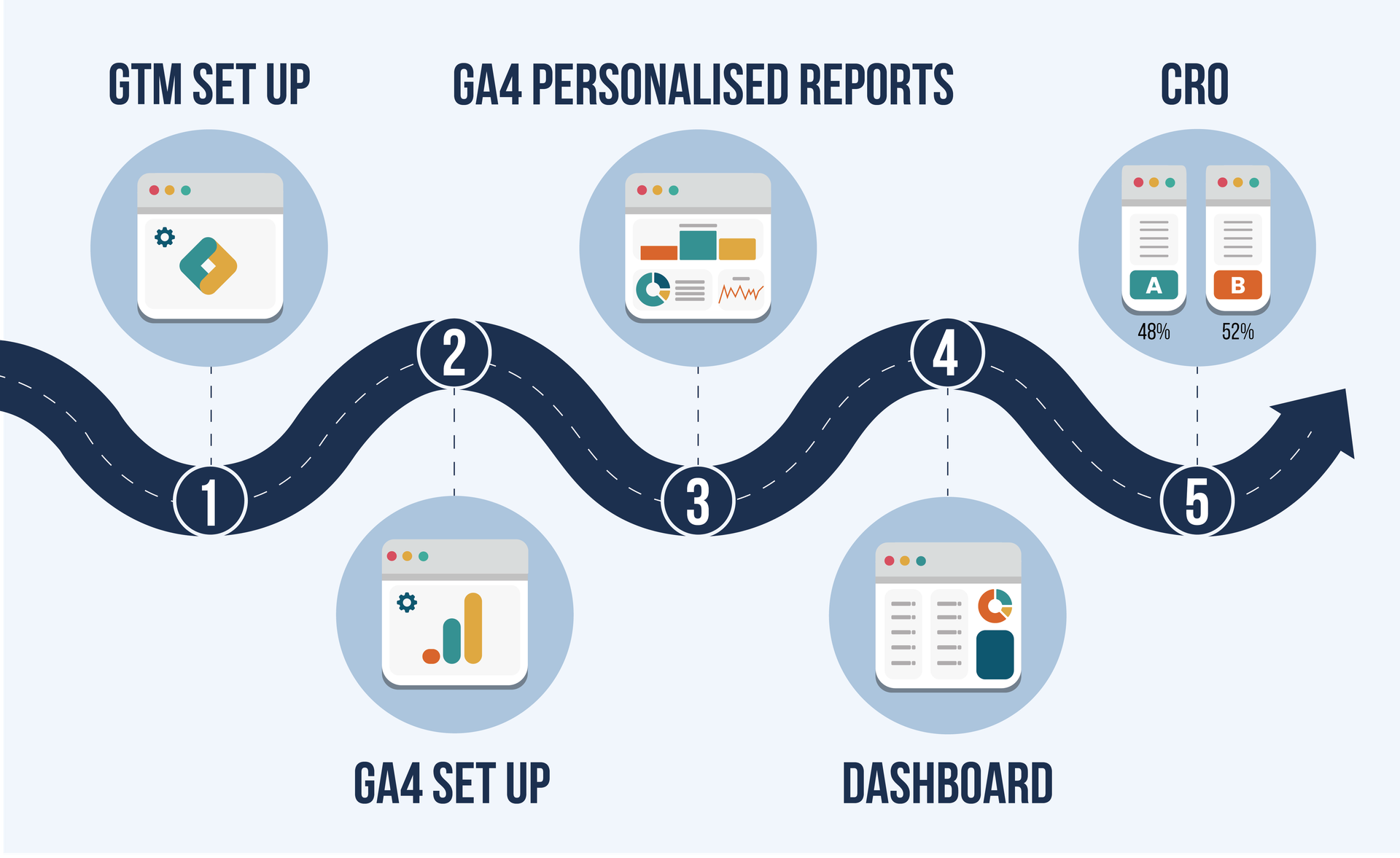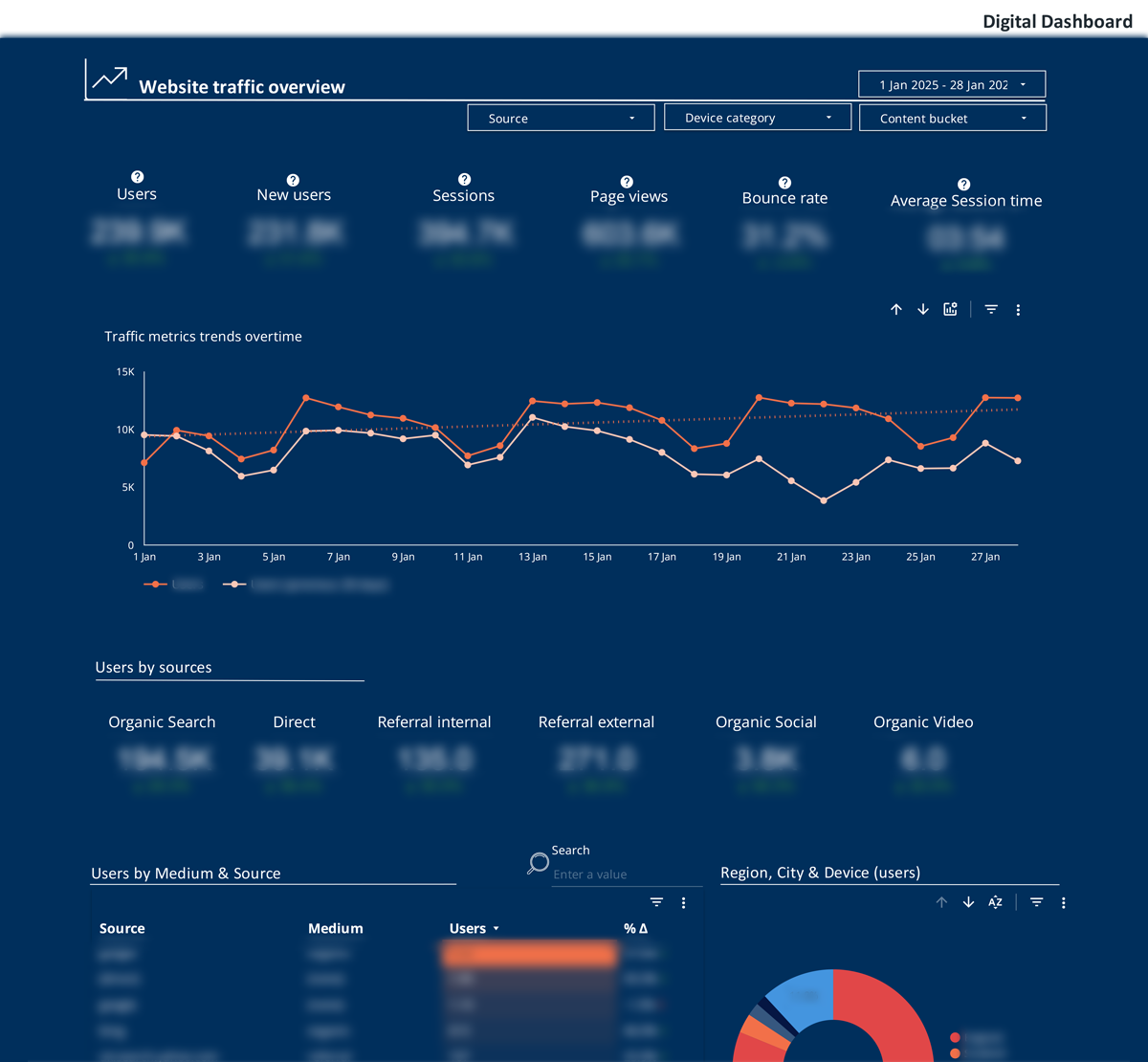Why is Digital Analytics Essential?
Digital analytics is like putting a magnifying glass on the behaviour of users on your site.
Continuous monitoring of analytics ensures that you stay on top of the game, ahead of the competition and find any problems as early as possible, whilst they are easy to fix and crucially before you see a downturn in user satisfaction.
Digital Analytics allows you to discover:
- Which pages attract the most attention.
- Where visitors abandon their journey through your site.
- How to optimise that user journey to generate better results.
Digital Analytics insights drive real-time optimisations, resulting in increased engagement and conversions
At Zoocha, we have a Digital Analytics Roadmap for you to follow
This starts with structuring the website’s data collection using Google Tag Manager (GTM), followed by the configuration of Google Analytics 4 (GA4), and through to the creation of dashboards and reports. These are all aimed at building a more robust data structure for starting an A/B testing process that will work to improve website conversion rates and user experience.

1. Google Tag Manager Setup
The basic setup is ideal if you need an initial tracking configuration, ensuring that essential website data is available in Google Analytics 4.
What will be configured?
- Creation of the GTM account and container for the website.
- Configuration of the Google Analytics 4 (GA4) tag to automatically collect data.
Which user interactions will be tracked?
With this setup, GA4 will automatically record some key events, such as:
- Clicks on links that lead to other websites.
- Downloads of files like PDFs, spreadsheets, and presentations.
- Form submissions on the website.
What will you be able to see?
In the Google Analytics 4 dashboard, you’ll be able to monitor these events through ready-made reports. For example, you can see how many people downloaded a specific file or how many submitted a contact form.
The advanced setup is for those who want a more detailed analysis of visitor behaviour on their website. It allows tracking of specific interactions that GA4 does not capture automatically.
What will be configured?
- Everything included in the basic setup.
- Tracking of custom events, such as interactions with specific website elements (buttons, links, toggles).
Which user interactions will be tracked?
In addition to the events from the basic setup, we’ll add:
- Clicks on important buttons, such as "Buy," "Learn More," or "Sign Up."
- Clicks on menus, tabs, drop-downs, and interactive elements on the website.
- Interactions with accordions and toggles, commonly used in FAQ sections.
- Time spent on the page and engagement with specific website sections.
What will you be able to see?
With this level of tracking, you’ll be able to understand which buttons are clicked the most, whether visitors are opening menus and exploring pages, and which content is actually being read. These insights will appear in GA4, allowing you to access more detailed metrics and make strategic decisions to improve the user experience.
2. Google Analytics 4 Setup
The basic setup is ideal for those who need a foundational tracking structure, ensuring that key visitor data is collected without complex configurations.
What will be configured?
- Creation of a GA4 account and properties for your websites.
- Implementation of GA4’s automatic event tracking.
Which user interactions will be tracked?
GA4 automatically tracks several key interactions without the need for additional configurations, including:
- Clicks on external links (when users leave your website).
- File downloads (such as PDFs, spreadsheets, and presentations).
- Form submissions.
- Scroll depth (when users scroll at least 90% way down a page).
- Site search queries (if the website has a search bar).
What will you be able to see?
In GA4, you’ll be able to monitor user engagement through pre-built reports. For example, you can see how many users downloaded a document, how many filled out a contact form, or which search terms they used on your site.
The advanced setup is designed for those who need deeper insights and custom tracking to understand user behaviour beyond GA4’s automatic capabilities.
What will be configured?
- Everything included in the basic setup.
- Configuration of custom events to track specific user interactions.
- Implementation of Enhanced E-commerce tracking (for e-commerce websites).
- Creation of custom dimensions and metrics for more detailed analysis.
- Setup of custom audiences for re-marketing and advertising purposes.
- Integration with Google Ads and Search Console for cross-platform insights.
What user interactions will be tracked?
In addition to the events from the basic setup, the advanced setup includes:
- Clicks on specific buttons, such as "Buy Now," "Contact Us," or "Subscribe."
- Interactions with navigation elements, like menus, dropdowns, and filters.
- Video engagement (tracking play, pause, and completion rates).
- E-commerce interactions (product views, add-to-cart actions, purchases, and checkout steps).
- Custom-defined user actions relevant to business goals.
What will you be able to see?
With this level of tracking, you’ll be able to analyse which buttons and features users engage with, how far they progress in the purchase funnel, and what content keeps them engaged the most.
3. Google Analytics Personalised Reports
Once your website has GTM and GA4 set up, we can create custom GA4 reports, such as funnel reports to identify drop-off points and user path reports to analyse common navigation paths.
Basic personalised reports are perfect if you need ready-made reports to track visitor activity without creating a custom dashboard. GA4 has built-in tools that allow you to explore key data about your website.
What will you receive?
- Access to GA4 Explorer reports, where you can filter and analyse data.
- Pre-configured reports showing traffic sources, user engagement, and conversions.
- Guidance on how to navigate GA4 and access your reports.
What will you be able to see?
- Where your visitors come from (Google, social media, direct visits, etc.).
- Which pages are the most popular and how much time users spend on them.
- How many people clicked on buttons, downloaded files, or submitted forms.
4. Digital Analytics Dashboard
To compliment those personalised reports, an advanced fully customised and interactive dashboard can be provided using Google's Looker Studio. This allows us to combine data from different sources and present information in an easy-to-understand format.
What will you receive?
- A custom dashboard in Looker Studio, tailored to your business needs.
- A clear and interactive overview of user behaviour, conversions, and website performance.
- Integration with other data sources like Google Search Console (for organic search insights) and Core Web Vitals (for site speed and performance metrics).
- Support in defining the most relevant KPIs for your business.
What will you be able to see?
- Traffic overview: A summary of how visitors arrive at your site.
- User interactions: Which buttons and forms users engage with the most.
- Search performance: What keywords bring traffic to your website (via Search Console).
Website performance: Insights into site speed and loading times (via Core Web Vitals).
5. Conversion Rate Optimisation (CRO)
With a structured data collection and GA4 setup, you are ready to start the CRO process, testing hypotheses to improve your conversion rate and user experience.
For websites that are not e-commerce or do not have transactional conversions, this will focus on enhancing the user experience, reducing bounce rates, and increasing interactions like form submissions, downloads, or sign-ups, leading to better overall site effectiveness.
We set up experiments, monitor results in collaboration with your team, and, if successful, you decide whether to implement the evidence-informed changes with our development team.
This journey in practice
Through following this journey, you will have an improved ability to:
- Visualise your goals and KPIs through GA4 reports and your dashboard.
- Easily analyse the data, with clear structure and visualisation.
- Generate monthly reports to track website performance for stakeholders.
- Identify website gaps and develop hypotheses for A/B testing to improve your goals and user experience.
Below is a screenshot of a dashboard created for our client, an NHS Foundation Trust based in London, UK:

With the data structured and accessible through a custom dashboard, the Trust has been able to uncover key user insights, for example:
- By identifying the most common user paths, we can simplify access to key features, significantly improving the goal completion rate.
- Knowing the proportion of mobile, desktop, or tablet accesses, we can focus website responsiveness and maintenance efforts more effectively.
- By identifying which channels and campaigns drive higher-quality traffic (users who take more valuable actions), the client can invest in more targeted media campaigns.
Start small
Analytics and optimisation is a journey - you can start small and build up increasing levels of insight to ensure your investment is achieving the desired results. If you haven't started that journey, now is always a good time to make that first step.
Ready to start your Digital Analytics journey?
Do you want to find out more about Digital Analytics, perhaps just to get a better initial understanding of all those numbers GA4 is showing you, or for a full-blown dashboard and continuous CRO? Our Digital Analytics experts will be on hand to talk you through the benefits and possibilities. Just reach out to your Client Services Manager or our business development team at [email protected].



